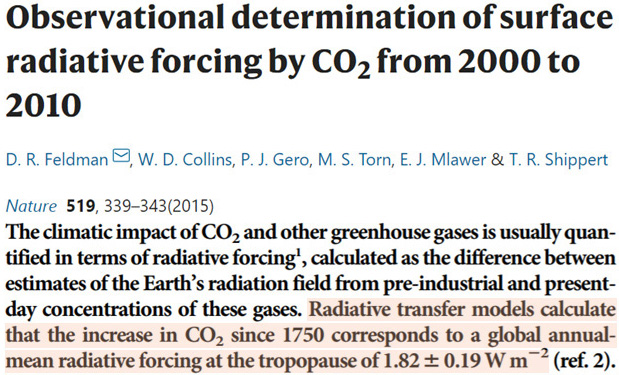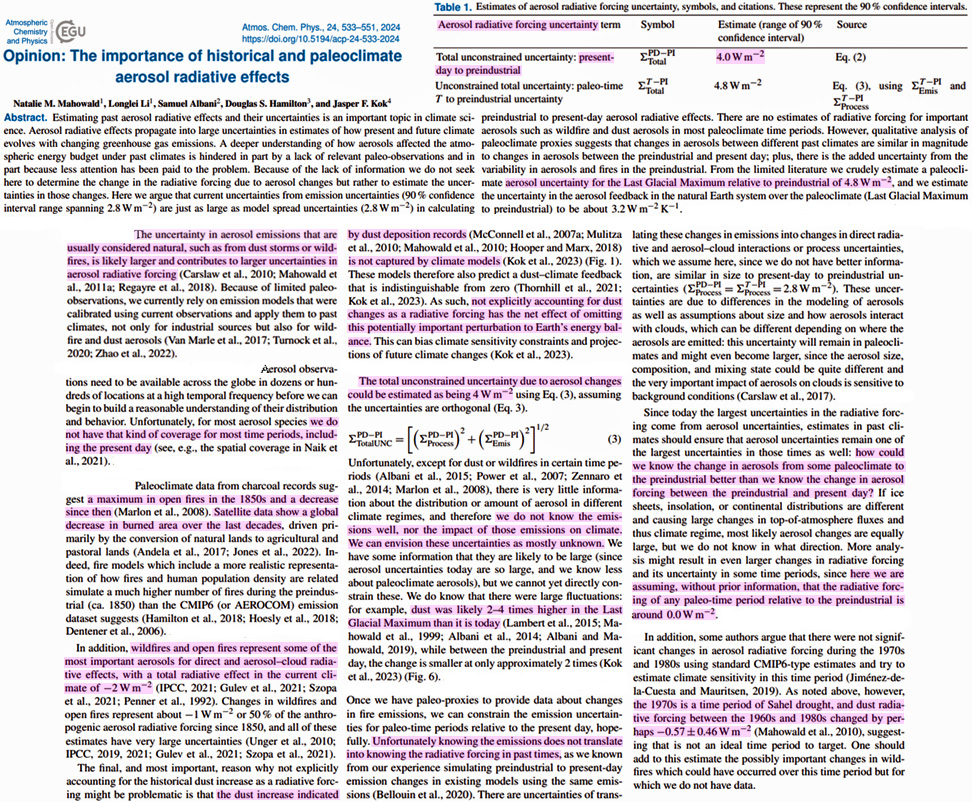The radiative effect of natural wildfire aerosol forcing alone can be said to fully cancel out the total accumulated forcing from 170 years of CO2 increases in the current climate.
It has been estimated that the total change in climate forcing (radiation imbalance) from the 1750 to present CO2 concentration increase has been 1.82 W/m².

Image Source: Feldman et al., 2015
New research suggests today’s climate models omit an “important perturbation to Earth’s energy balance” because they fail to include the natural climate forcing potential from aerosols produced by wildfires and dust loading.
Climate models expressly assume this non-volcanic natural aerosol forcing is not present, or 0.0 W/m², even though it has been estimated that aerosol forcing from wildfire emissions alone – which were much higher during the preindustrial period before declining to today’s levels – deliver a “radiative effect in the current climate of -2 W/m².” Therefore, this natural climate forcing effect can be said to, by itself, fully cancel the surface forcing from the post-industrial CO2 increases.
Furthermore, the estimated 4 W/m² uncertainty in preindustrial-to-present (1850-) aerosol climate forcing from natural wildfire emissions and dust is also over two times larger than 270 years of CO2 concentration increases (1.82 W/m² since 1750). This effectively means that anthropogenic CO2 forcing is too uncertain to clearly separate from natural aerosol forcing.

Image Source: Mahowald et al., 2024
Below are key quotes from this research paper.
1) Regarding the natural aerosol forcing uncertainty missing in the models…
“The uncertainty in aerosol emissions that are usually considered natural, such as from dust storms or wildfires, is likely larger and contributes to larger uncertainties in aerosol radiative forcing.”
“There are no estimates of radiative forcing for important aerosols such as wildfire and dust aerosols in most paleoclimate time periods.”
“…dust deposition records [are] not captured in climate models. These models therefore also predict a dust-climate feedback that is indistinguishable from zero. As such, not explicitly accounting for dust changes as a radiative forcing has the net effect of omitting this potentially important perturbation to Earth’s energy balance.”
“…here we are assuming, without prior information, that the radiative forcing of any paleo-time period relative to the preindustrial is around 0.0 W/m².”
“…we do not know the emissions [from wildfires or dust] well, nor the impact of those emissions on climate. We can envision these uncertainties as mostly unknown.”
2) Regarding the larger radiative forcing impact and uncertainty values of natural aerosols than CO2 forcing…
“In addition, wildfires and open fires represent some of the most important aerosols for direct and aerosol-cloud radiative effects, with a total radiative effect in the current climate of -2 W/m².”
“The total unconstrained uncertainty due to aerosol changes [since 1850] could be estimated as being 4 W/m².”
“…dust [radiative forcing] was likely 2-4 times higher in the Last Glacial Maximum [~25,000 to 17,000 years ago] than it is today.”
“From the limited literature we crudely estimate a paleoclimate aerosol uncertainty for the Last Glacial Maximum relative to preindustrial [1850] of 4.8 W/m².”
“Paleoclimate data from charcoal records suggest a maximum in open fires in the 1850s and a decrease since then. Satellite data show a global decrease in burned area over the last decades…”
“…the 1970s is a time period of Sahel drought, and dust radiative forcing between the 1960s and 1980s changed by perhaps -0.57 ±0.46 W/m².”





More Richard sponsored baloney, this time with minimal data
Air pollution has been declining since about 1980 and that would cause less daytime solar energy reaching Earth’s surface.
But most of the warming since 1975 has been at night,
Wildfires are mainly during the six warmest months of the year.
A decline in wildfires would reduce air pollution in the six warmest months of the year. And not affect the six coldest months of the year.
Is the declining trend of active fires since 2000 (NASA Active Fires Index data) causing more warming in the six warmest months, but not affecting the six coldest months?
Most of the warming since 1975 has been in the six coldest months of the year, and that can not be caused by a decline of forest fire air pollution in the six warmest months of the year,
Better luck next time
Poor Richard Green. He’s fighting sn imaginary fight. Since it isn’t a real fight he csn’t “lose,” but he ca’t win either.
In the event he is able to reconsider his position, based on the facts, here are s few of those pesky little nuisances. (See movie here)
https://joannenova.com.au/2024/03/unpermitted-documentaries-you-can-send-to-friends/
CORRECTION
Air pollution has been declining since about 1980 and that would cause MORE daytime solar energy reaching Earth’s surface.
OK,OK. However air contamination from wearing out rubber tires and dust blown in the air from mowing vehicles are not taken into consideration! Or I’m mistaken?
Humans are only using only about 15 percent of the total surface of the planet for infrastructure and farming.
Particulate matter (PM) does block some sunlight. If PM was affecting the climate, land surfaces would be warming lslower than sea surfaces. In fact, land surfaces are warming 50% faster than sea surfaces according to UAH data since 1979
[…] From NoTricksZone […]
[…] Uncertainty In Natural Forcing From Wildfire, Dust Aerosols 2 Times Larger Than Total CO2 Forcing […]